Wissenschaftliche Evidenz
Forschung
NightWatch+ ist ein Ergebnis jahrzehntelanger gemeinsamer Forschung des niederländischen TeleEpilepsie-Konsortiums.

- Tonisch-klonische Anfälle
- Tonische Anfälle (Cluster oder längerdauernd)
- Hyperkinetische Anfälle
- Myoklonische Anfälle (Clustern)
Multimodale Anfallerkennung
NightWatch erkennt nächtliche epileptische motorische Anfälle, indem es Veränderungen der Herzfrequenz und spezifische Bewegungsmuster über einen tragbaren Sensor erfasst. Dabei kommt eine fortschrittliche PPG-Technologie (Photoplethysmographie) zur Herzfrequenzüberwachung sowie ein 3D-Beschleunigungssensor zur Bestimmung der Körperposition und Bewegung zum Einsatz. Der Erkennungsalgorithmus wurde mithilfe von Langzeitdaten von Erwachsenen und Kindern (über 4 Jahre alt) mit tausenden nächtlichen Anfällen optimiert und anhand von Videoaufnahmen als Referenzstandard validiert.
Validierte Erkennungsleistung
Die Leistungsfähigkeit von NightWatch wurde in mehreren multizentrischen Studien unter realistischen Bedingungen im häuslichen Umfeld validiert. Als Referenzstandard diente dabei die manuelle Videoauswertung, die von speziell geschultem Pflegepersonal durchgeführt wurde. Das Studiendesign ermöglichte eine Langzeitbewertung in Situationen, in denen ein kontinuierliches EEG nicht praktikabel war. Um mögliche Verzerrungen durch übersehene Anfälle zu minimieren, dokumentierten die Pflegekräfte alle beobachteten Anfälle. Zusätzlich unterstützten automatisierte Hilfsmittel wie Bettsensoren und Videoanalysen die Detektion.Zur weiteren Qualitätssicherung überprüften die Studienpfleger stichprobenartig 5–10 % der Videoaufzeichnungen nochmals manuell.
In den klinischen Studien wurden mediane Sensitivitäten für die wichtigsten motorischen Anfallstypen ermittelt: 86 % bei Erwachsenen und 100 % bei Kindern. Speziell bei tonisch-klonischen Anfällen wurde eine mediane Sensitivität von 96 % bei Erwachsenen und 100 % bei Kindern (über 4 Jahre alt) ermittelt. Die durchschnittliche Fehlalarmrate lag bei 0,04 pro Stunde. Die gemessenen Fehlalarmraten variierten stark zwischen den Nutzern; viele Fehlalarme konnten als kleinere Anfälle identifiziert werden, die nicht den Kriterien für schwere nächtliche motorische Anfälle entsprachen.
Other relevant publications on NightWatch or its working principles
- Zelano, J., Beniczky, S., Ryvlin, P., Surges, R., Tomson, T., & the ILAE SUDEP Task Force. (2023). Report of the ILAE SUDEP Task Force on national recommendations and practices around the world regarding the use of wearable seizure detection devices: A global survey. Epilepsia Open. doi.org/10.1002/epi4.12801
Summary:
The article „Report of the ILAE SUDEP Task Force on national recommendations and practices around the world regarding the use of wearable seizure detection devices“ examines global recommendations and practices concerning the use of wearable devices for seizure detection. It highlights the importance of these technologies in monitoring seizures and their potential to enhance patient safety. The article mentions that NightWatch has been clinically tested in the Netherlands and is used in epilepsy care. The device has contributed to increased patient safety and improved nighttime monitoring. - Hadady L, Klivényi P, Fabó D, Beniczky S. Real-world user experience with seizure detection wearable devices in the home environment. Epilepsia. 2022;00:1–6. doi: 10.1111/epi.17189
Summary:
The article examines the practical usability and effectiveness of wearable seizure detection devices in a home setting. It highlights the general feasibility and benefits of automated seizure detection at home, which can contribute to improved monitoring and safety for patients with epilepsy. - van Elmpt WJC, Nijsen TME, Griep PAM, Arends JBAM. A model of heart rate changes to detect seizures in severe epilepsy. Seizure. 2006;15(6):366–75. doi: 10.1016/j.seizure.2006.03.005
Summary:
The article explores using heart rate changes to detect seizures in patients with severe epilepsy. It developed two algorithms to monitor heart rate patterns, identifying significant changes like tachycardia and bradycardia during seizures. The study found that heart rate changes occurred in most patients. It concluded that heart rate changes can be used for automatic seizure detection, provided the model parameters are tailored to individual patients. - Massé F, Penders J, Serteyn A, van Bussel M, Arends J. Miniaturized wireless ECG-monitor for real-time detection of epileptic seizures. WH’10. 2010 Oct; 111-117. doi: 10.1145/1921081.1921095
Summary:
The article highlights the feasibility of using heart rate changes as indicators for seizure activity, offering a non-invasive method for monitoring patients with epilepsy. - Lamberts RJ, Thijs RD, Laffan A, Langan Y, Sander JW. Sudden unexpected death in epilepsy: People with nocturnal seizures may be at highest risk: Nocturnal Seizures as a Risk for SUDEP. Epilepsia. 2012;53(2):253–7. doi: 10.1111/j.1528-1167.2011.03360.x
Summary:
The article investigates the association between nocturnal seizures and the risk of sudden unexpected death in epilepsy (SUDEP). The study suggests that individuals experiencing seizures during sleep may have an increased risk of SUDEP. These findings underscore the importance of preventive measures, which may include nighttime monitoring and interventions to reduce seizure frequency during sleep. - van Andel J, Leijten F, van Delden H, van Thiel G (2015) What Makes a Good Home-Based Nocturnal Seizure Detector? A Value Sensitive Design. PLoS ONE 10(4): e0121446. doi: 10.1371/journal.pone.0121446
Summary:
The study investigates the development of a device for in-home detection of nocturnal seizures in patients with severe epilepsy. It identifies five key values: health, trust, autonomy, accessibility, and reliability. These values were then linked to design choices for the device. - Arends JB, van Dorp J, van Hoek D, Kramer N, van Mierlo P, van der Vorst D, et al. Diagnostic accuracy of audio-based seizure detection in patients with severe epilepsy and an intellectual disability. Epilepsy Behav. 2016;62:180–5. doi: 10.1016/j.yebeh.2016.06.008
Summary:
The study evaluates the use of audio monitoring for detecting major seizures in patients with severe epilepsy. It suggests that audio-based detection could be used alone or in combination with other systems for better seizure monitoring. - van Andel J, Thijs RD, de Weerd A, Arends J, Leijten F. Non-EEG based ambulatory seizure detection designed for home use: What is available and how will it influence epilepsy care? Epilepsy Behav. 2016;57:82–9. doi: 10.1016/j.yebeh.2016.01.003
Summary:
The article reviews existing non-EEG seizure detection systems suitable for home use. It evaluates various devices and algorithms, discussing their potential impact on epilepsy management. The study emphasizes the importance of these technologies in enhancing patient safety and monitoring outside clinical settings. - van der Lende M, Cox FME, Visser GH, Sander JW, Thijs RD. Value of video monitoring for nocturnal seizure detection in a residential setting. Epilepsia. 2016;57(11):1748–53. doi: 10.1111/epi.13558
Summary:
Conducted in a residential care facility, the research found that video Monitoring significantly increased the identification of seizures requiring clinical intervention. The study concluded that Video monitoring is a valuable tool for enhancing patient safety and improving the management of nocturnal seizures in such settings. - van Andel J, Ungureanu C, Arends J, Tan F, Van Dijk J, Petkov G, et al. Multimodal, automated detection of nocturnal motor seizures at home: Is a reliable seizure detector feasible? Epilepsia Open. 2017;2(4):424–31. doi: 10.1002/epi4.12076
Summary:
The study investigates the feasibility of using non-electroencephalographic (non-EEG) signals—specifically heart rate and accelerometry—to detect various types of nocturnal seizures, including tonic, tonic-clonic, hypermotor, and clusters of short myoclonic/tonic seizures. The research involved monitoring patients during diagnostic video-EEG examinations. The findings suggest that automated seizure detection using these non-EEG signals is feasible and could enhance patient safety by enabling timely interventions. - Geertsema EE, Thijs RD, Gutter T, Vledder B, Arends JB, Leijten FS, et al. Automated video-based detection of nocturnal convulsive seizures in a residential care setting. Epilepsia. 2018;59:53–60. doi: 10.1111/epi.14050
Summary:
The study evaluates the effectiveness of a video-based algorithm for detecting nocturnal convulsive seizures in individuals with epilepsy residing in a care facility. The algorithm analyzes group velocity signals derived from video sequences to identify seizures. The study concludes that this automated system is effective for real-time seizure detection in residential care settings, potentially enhancing patient safety.
NightWatch für klinische Studien
Optimieren Sie Ihre klinischen Studien mit hochwertigen, langfristigen Schlafdaten, die mit minimaler Belastung für die Patienten erfasst werden. NightWatch liefert Ihnen wichtige Kennzahlen wie PPG-Daten (Photoplethysmographie), Bewegungsmuster und die Anfallshäufigkeit im Zeitverlauf – und unterstützt damit vielfältige Forschungsanforderungen durch:
- NightWatch Datenportal
- NightWatch Daten API
- NightWatch Forschungskoffer
NightWatch Daten Portal
Die Online-Datenmonitoring-Plattform ermöglicht es, Anfälle zu annotieren, zusätzliche Informationen hinzuzufügen und detaillierte Daten zu Herzfrequenz und Bewegung während des Schlafs abzurufen. Dieses benutzerfreundliche Portal steht allen NightWatch-Standardnutzern zur Verfügung und bietet eine unkomplizierte Möglichkeit, Anfalldaten über längere Zeiträume hinweg nachzuverfolgen.
NightWatch API
Die NightWatch-Daten-API ermöglicht die Integration mit externen Forschungsplattformen oder digitalen Anfallstagebüchern. So können nächtliche Anfallsalarmierungen, Herzfrequenzdaten und Bewegungsmuster in Echtzeit erfasst und für wissenschaftliche Auswertungen genutzt werden.
NightWatch Forschungskoffer
The plug-and-play Forschungskoffer ist für den Einsatz im häuslichen Umfeld oder in Institutionen im Rahmen von klinischen Studien und Forschungsprojekten konzipiert. Es ermöglicht die langfristige, objektive Erfassung von nächtlichen Anfalldaten, einschließlich:
- Anfallsalarme: Zeitstempel für Anfallsalarme folgender Anfälle:
– Tonisch-klonische Anfälle
– Tonische Anfälle (Cluster oder längerdauernd)
– Hyperkinetische Anfälle
– Myoklonische Anfälle (Cluster) - Raw PPG Data: Beat-to-beat Herzfrequenz Messung
- XYZ Accelerometer Data: Bewegungs Tracking
- Körperpositions Data
- Video Monitoring: Hochwertige Infrarotkamera mit kontinuierlicher Video- und Audioaufzeichnung, die eine klinische Anfallannotation nach dem Video-Goldstandard ermöglicht.
Eigenschaften des Forschungskoffers
Der NightWatch Forschungskoffer wird in einer abschließbaren, tragbaren Box mit Rollen geliefert und enthält:
- NightWatch (komplettes System)
- Integrierter PC mit externer Festplatte
- 4G router für remote Zugang
- Mehrere externe Relais- oder LAN-Anschlüsse für zusätzliche Geräte
- Infrarot Nachtsichtkamera
- Aktives Kühlsystem
Alle Daten werden lokal gespeichert und können bei Bedarf remote betrachtet werden, via LAN oder 4G.

Contact:
Weitere Information zum Ablauf und Preis, bitte per email info@nightwatchepilepsy.com
Zitierte Literatur
- Arends J, Thijs RD, Gutter T, Ungureanu C, Cluitmans P, van Dijk J, et al. Multimodal nocturnal seizure detection in a residential care setting: A long-term prospective trial, Neurology. 2018 Nov 20; 91(21):e2010-e2019. doi: 10.1212/WNL.0000000000006545
- Beniczky S, Wiebe S, Jeppesen J, Tatum WO, Brazdil M, Wang Y, et al. Automated seizure detection using wearable devices: A clinical practice guideline of the International League Against Epilepsy and the International Federation of Clinical Neurophysiology. Epilepsia. 2021 Mar; 62(3):632-646. doi: 10.1016/j.clinph.2020.12.009.
- Lazeron RHC, Thijs RD, Arends J, Gutter T, Cluitmans P, van Dijk J, et al. Multimodal nocturnal seizure detection: Do we need to adapt algorithms for children? Epilepsia. 2022; 7(3):406–13. doi: 10.1002/epi4.12618
- van Westrhenen A, Lazeron RHC, van Dijk JP, Leijten FSS, Thijs RD, the Dutch TeleEpilepsy Consortium. Multimodal nocturnal seizure detection in children with epilepsy: A prospective, multicenter, long‐term, in‐home trial. Epilepsia. 2023. doi: 10.1111/epi.17654
- Engelgeer A, van Westrhenen A, Thijs RD, Evers SMAA. An economic evaluation of the NightWatch for children with refractory epilepsy: Insight into the cost-effectiveness and cost-utility. Seizure. 2022;101:156–61. doi: 10.1016/j.seizure.2022.08.003



